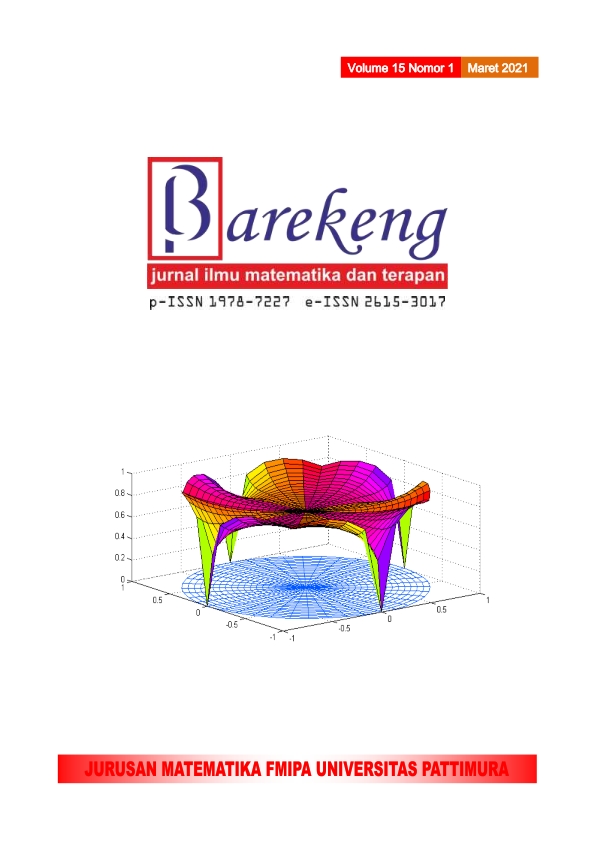PENDEKATAN ANALISIS DISKRIMINAN PADA PEMBELAJARAN DARING DI MASA PANDEMI COVID-19
Abstract
Online learning is solution that implemented in the midst of the COVID-19 pandemic. Since COVID-19 pandemic, the learning process at UMSIDA used 100% online learning with UMSIDA e-learning media.It can accommodate students to carry out distance learning. So far, research has not been carried out readiness of students to take part in online learning during the COVID-19 pandemic. Based on this, this research focuses on knowing the readiness of students to take online lectures during the COVID-19 pandemic using discriminant analysis. Based on the results of the analysis of the predictor variable, the strongest differentiator is the flexibility of lecture time (X1) because the variable with the largest coefficient. This means that the variable time flexibility (X1) has the strongest dividing power against online learning readiness during the COVID-19 pandemic. In addition, it also known that according to the student's perspective, the learning media that makes interaction with lecturers the most easy and the learning media that makes it the most easy to understand the material is using video conferencing (Zoom, Google Meet, etc.). On the other hand, choice of the learning system most chosen by students when the COVID-19 pandemic ends is online system 30% and offline 70%.
Downloads
References
Y. D. Cahyono, “E-learning (Edmodo) Sebagai Media Pembelajaran Sejarah,†J. Penelit., vol. 18, no. 2, pp. 102–112, 2015.
Rusman, Seri Manajemen Sekolah Bermutu: Model-Model Pembelajaran Mengembangkan Profesionalitas Guru. Jakarta: PT Raja Grafindo Persada, 2012.
A. Sadikin and A. Hamidah, “Pembelajaran Daring di Tengah Wabah Covid-19,†BIODIK, vol. 6, no. 2, pp. 109–119, Jun. 2020, doi: 10.22437/bio.v6i2.9759.
O. I. Handarini and S. S. Wulandari, “Pembelajaran Daring Sebagai Upaya Study From Home (SFH) Selama Pandemi Covid 19,†J. Pendidik. Adm. Perkantoran, vol. 8, no. 3, pp. 496–503, 2020.
H. Putria, L. H. Maulana, and D. A. Uswatun, “Analisis Proses Pembelajaran Dalam Jaringan (DARING) Masa Pandemi COVID-19 pada Guru Sekolah Dasar,†J. basicedu, vol. 4, no. 2, pp. 861–872, 2020, doi: 10.31004/basicedu.v4i4.445.
W. A. F. Dewi, “Dampak COVID-19 terhadap Implementasi Pembelajaran Daring di Sekolah Dasar,†Edukatif J. Ilmu Pendidik., vol. 2, no. 1, pp. 55–61, 2020, doi: 10.31004/edukatif.v2i1.89.
J. Hair, W. Black, B. Babin, and R. Anderson, Multivariate Data Analysis, 8 th Editi. New Jersey: Prentice-Hall, 2010.
E. W. Thomas, M. J. Marr, A. Thomas, R. M. Hume, and N. Walker, “Using discriminant analysis to identify students at risk,†Proc. - Front. Educ. Conf., no. March 2014, pp. 185–188, 1996, doi: 10.1109/fie.1996.569940.
M. J. Alrawashdeh, T. R. Radwan, and K. A. Abunawas, “Performance of Linear Discriminant Analysis Using Different Robust Methods,†Eur. J. Pure Appl. Math., vol. 11, no. 1, p. 284, 2018, doi: 10.29020/nybg.ejpam.v11i1.3176.
A. H. Blasi, “Applications of Discriminant Analysis,†no. January, 2020.
S. Ayinla and B. Kehinde Adekunle, “An Overview and Application of Discriminant Analysis in Data Analysis,†IOSR J. Math., vol. 11, no. 1, pp. 2278–5728, 2015, doi: 10.9790/5728-11151215.
H. Bakari, A. Isa, and U. Zannah, “Application of Discriminant Analysis in Modelling Students’Placement in Colleges of Education,†vol. 52, no. 249, 2015.
A. Tharwat, T. Gaber, A. Ibrahim, and A. E. Hassanien, “Linear discriminant analysis: A detailed tutorial,†AI Commun., vol. 30, no. 2, pp. 169–190, 2017, doi: 10.3233/AIC-170729.
N. A. A. Shashoa, N. A. Salem, I. N. Jleta, and O. Abusaeeda, “Classification depend on linear discriminant analysis using desired outputs,†2016 17th Int. Conf. Sci. Tech. Autom. Control Comput. Eng. STA 2016 - Proc., no. December 2016, pp. 328–332, 2017, doi: 10.1109/STA.2016.7952041.
R. J. Iskandar, “Penerapan Alggoritma Linear Discriminant Analysis (LDA) untuk Pengenalan Wajah Sebagai Pemantau Kehadiran Karyawan,†vol. IX, no. 01, 2013.
Authors who publish with this Journal agree to the following terms:
- Author retain copyright and grant the journal right of first publication with the work simultaneously licensed under a creative commons attribution license that allow others to share the work within an acknowledgement of the work’s authorship and initial publication of this journal.
- Authors are able to enter into separate, additional contractual arrangement for the non-exclusive distribution of the journal’s published version of the work (e.g. acknowledgement of its initial publication in this journal).
- Authors are permitted and encouraged to post their work online (e.g. in institutional repositories or on their websites) prior to and during the submission process, as it can lead to productive exchanges, as well as earlier and greater citation of published works.






1.gif)



